![[Return to Physics Homepage]](./../../physics.gif)
![[Return to Mike Coombes' Homepage]](./../../coombes.gif)
![[Return to List of Handouts]](./../../handouts.gif)
![[Return to Problem Sets]](./../../problems.gif)
![[Return to List of Solutions]](./../../solutions.gif)

(b) 56 g/cm3 to kg/m3

Write vectors equations for each diagram below.
| (a) |  |
(b) |  |
| (c) | 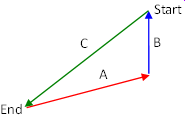 |
(d) | 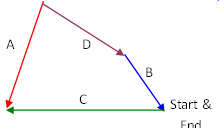 |
| (e) |  |
(f) | 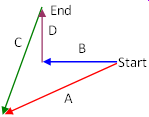 |
| (a) |  |
(b) |  |
| (c) |  |
(d) |  |
| (e) |  |
(f) |  |
![[Return to Top of Page]](./../../top.gif)
First we get the magnitude of the momenta:  and
and  . Next we neatly sketch the problem
and its solution.
. Next we neatly sketch the problem
and its solution.
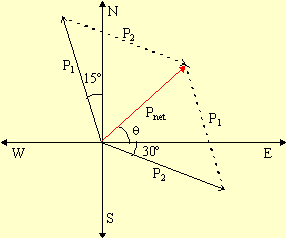
Vector problems are solved by breaking the given vectors into
their i and j components.
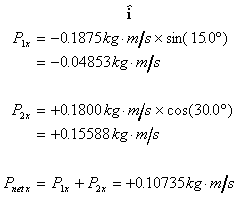

Using Pythagoras' Theorem,  . We use
trigonometry to find the direction. The angle is
. We use
trigonometry to find the direction. The angle is  .
The total or net momentum is thus 0.141 kg m/s at 40.3° north
of east.
.
The total or net momentum is thus 0.141 kg m/s at 40.3° north
of east.
First we neatly sketch the problem and its solution.

Vector problems are solved by breaking the given vectors into
their i and j components.

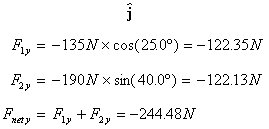
Using Pythagoras' Theorem,  . We use
trigonometry to find the direction. The angle is
. We use
trigonometry to find the direction. The angle is  .
The total or net force is thus 260 N at 70.1° south of east.
It would be more common to state this as 260 N at 19.9° east of
south.
.
The total or net force is thus 260 N at 70.1° south of east.
It would be more common to state this as 260 N at 19.9° east of
south.
First, we must realize that the velocity that the observer sees
is the sum of the velocity of the boat and the velocity of the
current, i.e.  . Since we are looking
for
. Since we are looking
for  , we are dealing with the subtraction
of vectors which is the addition of the negative of a vector,
i.e.
, we are dealing with the subtraction
of vectors which is the addition of the negative of a vector,
i.e.  . To solve this, or any other vector
problem, we sketch the solution first.
. To solve this, or any other vector
problem, we sketch the solution first.
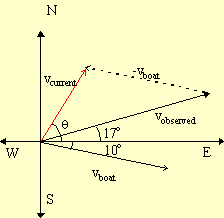
Vector problems are solved by breaking the given vectors into
their i and j components.


Using Pythagoras' Theorem,  . We use
trigonometry to find the direction. The angle is
. We use
trigonometry to find the direction. The angle is  .
The velocity of the current is thus 1.36 m/s at 56.2° north of
east.
.
The velocity of the current is thus 1.36 m/s at 56.2° north of
east.
Since we are told the total force and one of the forces, the
other force is given by  . To solve this,
or any other vector problem, we sketch the solution first.
. To solve this,
or any other vector problem, we sketch the solution first.
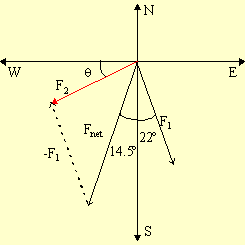
Vector problems are solved by breaking the given vectors into
their i and j components.
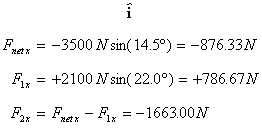

Using Pythagoras' Theorem,  . We use
trigonometry to find the direction. The angle is
. We use
trigonometry to find the direction. The angle is  .
The second force is thus 2200 N at 40.9° south of west.
.
The second force is thus 2200 N at 40.9° south of west.
Questions? mike.coombes@kpu.ca